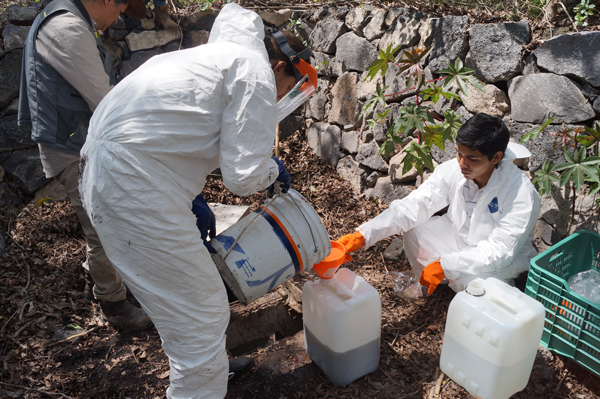Community Improvement of Sanitation, Farm, Tourism and Ecological Services for Sustainable Development in the Hñahñü Indigenous Community of El Alberto, Ixmiquilpan (Hidalgo, Mexico)
Organization: Parque Ecoalberto, Indigenous Community, El Alberto
Location:
While the affected community is the indigenous population of El Alberto, with approximately 1,500 inhabitants, there is not an exact estimate of the population floating between the United States and the community.
Country: Mexico
Other Organizations Involved:
- College of Sciences, Universidad Nacional Autónoma de México (UNAM)
- Institute of Engineering, UNAM
- Dept. Earth Sciences, University of Ottawa, Canada

Background
In very little time, the indigenous community of El Alberto went from being a marginalized community with serious hindrances to accessing “modern” development, to a community with a high level of foreign emigration, eventually leading to the exploitation of its resources through tourism activities. The search for further development and a better quality of living for its inhabitants brought about a new global vision, leading local inhabitants to manage, use and handle resources beyond what they had for millennia. Therefore, the project is aimed at finding the environmental advantages associated with emigration and the extensive ecosystem fragmentation in urban and farming zones. It also seeks to improve the economic benefits derived by the community from tourism and related activities, which enjoy quality services in terms of sustainability and lessons in ecological management. For example, the proper development of the tourism infrastructure will set the stage for comprehensive, environmentally sustainable management.
Goals
- Water. Improvement of the community’s sanitation and sewer system for household and tourism activities, through the design and construction of biological wastewater treatment plants ensuring the quality of treated water before reuse or discharge into the Tula River.
- Soil. Diagnosis of deforestation and deployment of long-term corrective and preventive programs through the creation of nurseries and permanent reforestation programs. Reconversion of conventional monocropping and the use of farm chemicals, into polyculture conservation methods, grazing and organic farming.
- Air. Carbon capture and greenhouse gas mitigation through efficient woodland and farm management.
- Society and sustainability. Awareness, sensitivity and training of natives committed to environmental health stewardship and resilience. Training of environmental technicians and plant species recovery through economic pressure and wildlife protection. Organization of ecotours and stricter enforcement of the laws, regulations and domestic and international standards on environmental management and sustainability.
Main Activities
- Water: characterization of sludge in two poorly designed septic tanks (STs) (NOM-004-SEMARNAT-2002); clearing and handling of accumulated sludge; stabilization and disposal of biosolids; elimination of the two poorly designed STs; evaluation and zoning of the community sewer system’s coverage and efficiency; drafting of a coverage diagram of the community sewer system; characterization of wastewater in two poorly designed STs and a water park (NOM-001-SEMARNAT-1996 and NOM-002-SEMARNAT-1998); design engineering of two STs and connected wetlands; building of biological wastewater treatment plants and wetland-connected STs (WC-STs) (in the water park and near springs); deployment of two WC-STs and community training (WC-ST operation and maintenance manual); monitoring of water quality at the two WC-STs, to stabilization and optimal operation.
- Soil: Community flower inventory; selection of mother plants and seed gathering for the following species: mesquite (Prosopis laevigata), cypress (Taxodium mucronatum), willow (Salix), agave (Agave lechuguilla), aloe (Aloe vera) and wetland plants; preparation of communal land intended for the nursery, zoning and seed and seedling areas; farm plot selection; soil characterization (type and fertility), farm chemical persistence analysis; weed and pest characterization; field testing of characterized farm plots: conventional method and conservation method (grazing, polyculture, organic farming); determination of greenhouse gas emissions at each experimental plot (CO2, CH4, N2O).
- Ecotourism: ecosystem tours and appreciation of ecotechniques developed as part of the project.
Results
Construction and deployment of two WC-ST; creation of a nursery with three native species; reconversion of farming methods aimed at strengthening an indigenous community and its ecosystem, as well as fostering low carbon economies (climate change) and the community’s environmental sustainability within the North American market. Two awareness publications, two international scientific publications, and the development of human resources (two townspeople with technical training and six bachelor-level theses).